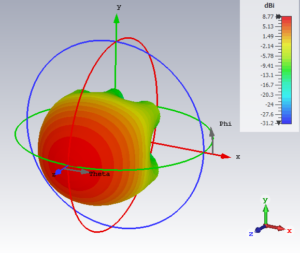A FMCW radio altimeter is an electronic device that uses radar technology, i.e. electromagnetic waves in the high-frequency range to measure a distance. It is primarily used to determine height above ground and is therefore used to measure ground distance in avionics for flying objects.
The term „RADAR“ stands for radio detection and ranging, which is a radio wave-based location and distance measurement.
A radio altimeter is standard in every commercial aircraft.

In the following a FMCW Radio Altimeter (FMCW = frequency modulated continuous wave) is presented. It transmits a frequency-modulated signal via a radar antenna, which propagates in space. If the electromagnetic wave hits an obstacle, the radar wave is either reflected or attenuated, depending on the material properties.
With a FMCW Radio Altimeter the height above ground can be determined. The main obstacle is the ground itself. It reflects the radar wave and in a receiving antenna in the FMCW radar sensor the reflected wave is detected, converted into an electrical signal and on the basis of the transit time, that the signal needs for the distance covered, a frequency difference proportional between transmitted and received signal can be determined. This frequency difference correlates with the distance.
Advantages of FMCW Radio Altimeter
- For pilots of small aircraft, it serves as an additional measuring instrument, which is of great help especially during the critical landing procedure and significantly increases safety, since the device can determine and output the actual distance to the ground in real time.
- Base for automated landing systems:
For example, ummanned flying objects such as remote-controlled drones or aircraft can be equipped with a FMCW Radio Altimeter to arrive safely on the ground as part of an automatic computer-controlled landing procedure – equip your drone with it! - Measuring distance over several hundred meters
- In contrast to optical systems for distance measurement, a radio altimeter is relatively insensitive to impurities and weather-related factors such as fog, clouds or rain.
- Modern fast microprocessor technology combined with intelligent digital signal processing allows precise measurements, very short measuring intervals and thus a high measuring frequency.
- Energy-saving thanks to low power consumption
- Radar technology at affordable costs (comparable devices cost several thousand euros/dollars)
(4.3 GHz Aircraft Radio Altimeter und 24 GHz Universal Radio Altimeter).
Special technical details for the 4.3 GHz aircraft version:
- Digitally generated frequency ramps
- modern oscillator design
- PLL [Phase Locked Loop]-supported Frequency Synthesis and Frequency Stabilization
- modern highly linear low-noise signal amplifiers
- CW transmission power lower than 100 mW (20 dBm)

